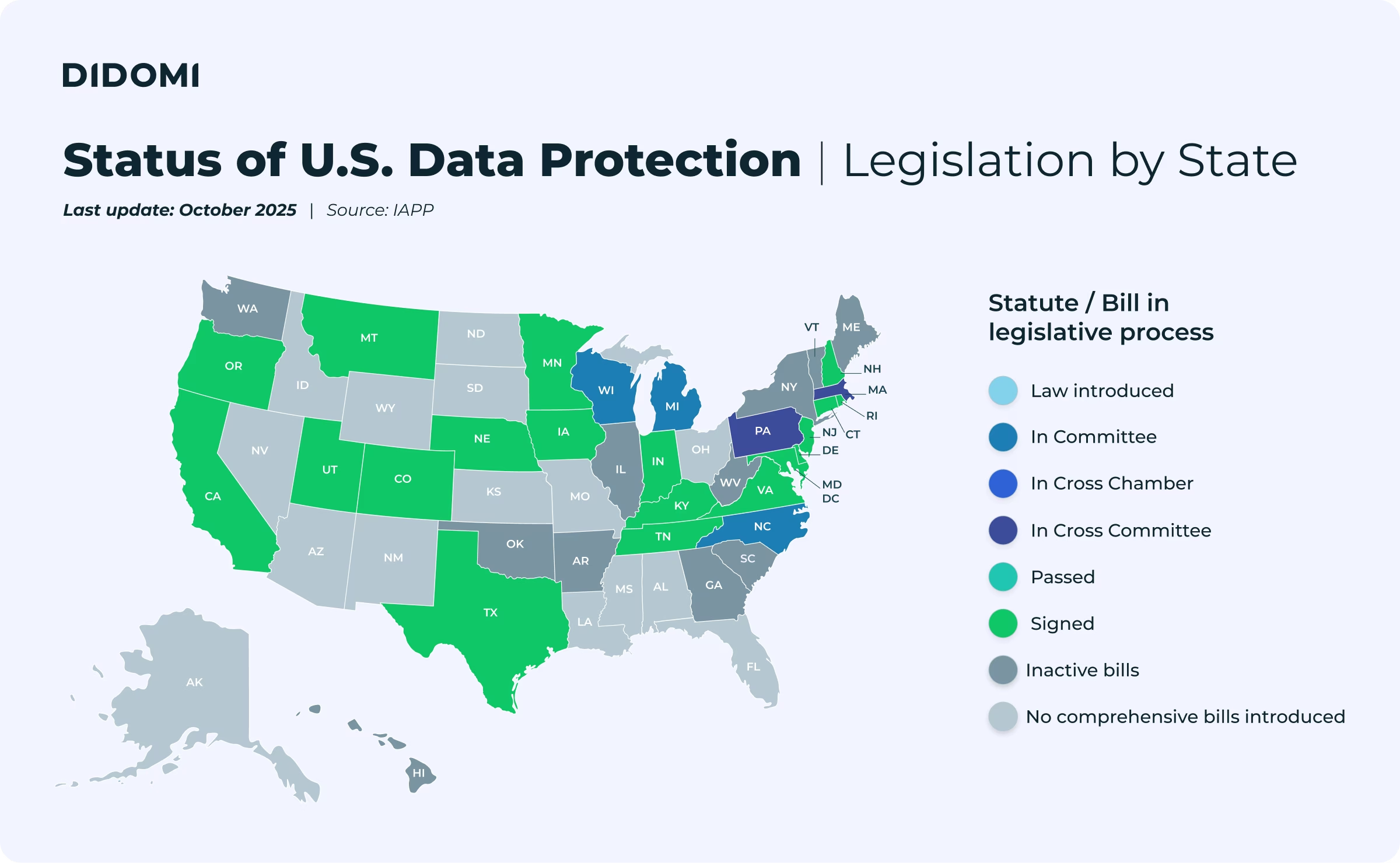In the Privacy Soapbox, we give privacy professionals, guest writers, and opinionated industry members the stage to share their unique points of view, stories, and insights about data privacy. Authors contribute to these articles in their personal capacity. The views expressed are their own and do not necessarily represent the views of Didomi.
Do you have something to share and want to take over the privacy soapbox? Get in touch at blog@didomi.io
I’m Sarah Reveillard, Head of Marketing and Communication at Didomi, with a background of over 25 years in digital marketing, where I’ve managed multi-million-dollar ad budgets for global brands to meet customers in the right place at the right time.
In this article, I'll share insights on the rise of Connected TV (CTV) in Europe and its advertising impact, covering programmatic CTV growth, industry standardization, cookie-less identity challenges, the role of Consent Management Platforms (CMPs), tightening privacy regulations, Google's CTV consent stance, and Automatic Content Recognition (ACR) technology—all while offering my perspective on balancing innovation with privacy and identity
The Rise of CTV in Europe
Connected TV (CTV) accounted for 46% of all ad views in Europe this year, marking a 31% increase compared to the same period in 2023. It has become the leading device for watching ad-supported content in the region.
However, this expansion brings complex privacy and identity challenges that need to be addressed proactively. The adoption of CTV is not just a fleeting trend but a fundamental shift in media consumption.

Factors contributing to this growth include:
- Increased internet penetration: With broadband connectivity becoming more accessible, streaming high-quality video content is now feasible for a larger portion of the population.
- Diverse content offerings: The proliferation of streaming services provides viewers with a wide array of content choices, from global platforms like Netflix and Amazon Prime Video to regional services.
- Shift in consumer behavior: Audiences, especially younger demographics, prefer on-demand content over traditional linear TV schedules.
For advertisers, this means access to a highly engaged audience that can be reached through more personalized and interactive ad experiences.
The growth of programmatic advertising and industry standardization
As CTV continues to expand, there's a parallel surge in programmatic advertising within this space. Programmatic advertising allows for automated, real-time buying and selling of ad inventory, making the advertising process more efficient and data-driven.
According to industry reports, programmatic CTV ad spend in Europe is expected to grow by over 20% annually through 2025. This growth is driving the need for industry-wide unification and standardization, leading to collaborations like the European Programmatic TV Initiative (EPTVI), where ad tech companies, publishers, and broadcasters work together to establish common protocols and standards. These efforts aim to:
- Simplify the programmatic ecosystem: Standardization reduces fragmentation, making it easier for advertisers to execute campaigns across multiple platforms.
- Enhance transparency: Unified standards help in building trust by providing clear guidelines on data usage and ad delivery.
- Improve Compliance: Standard protocols ensure that all parties adhere to privacy regulations like GDPR, which is crucial for maintaining user trust.
This move towards industry standardization allows CMPs like ours to provide a consistent user experience across platforms and devices.
Identity challenges in a cookieless environment
One of the unique aspects of CTV is that it's inherently a cookieless environment. Unlike web and mobile platforms, connected TVs do not support cookies, which have historically been a cornerstone for online identity and tracking. This raises the question: How can advertisers effectively target and measure campaigns in CTV without cookies?
In the CTV ecosystem, identity is primarily based on household IP addresses and device identifiers provided by smart TV operating systems like Tizen (Samsung) and webOS (LG). While these identifiers facilitate household-level targeting, they also present limitations:
- Frequency capping issues: Without precise identifiers, users may be exposed to the same ads repeatedly across different apps and services, leading to a poor user experience.
- Household vs. individual targeting: CTV often targets households rather than individual users, making it challenging to deliver personalized content.
- Privacy concerns: Relying on IP addresses and device IDs raises privacy issues, especially under regulations like GDPR.
To overcome these limitations and address the associated privacy concerns, the industry is shifting towards solutions that prioritize user consent and data protection. This has led to the rise of CTV Consent Management Platforms (CMPs), which are essential in empowering users to control their personal data and in helping advertisers tailor viewing experiences responsibly.
The role of Consent Management Platforms (CMPs) and alternative identifiers
Consent Management Platforms (CMP) are crucial in navigating these identity challenges. Didomi specialize in providing CMP solutions that help publishers and advertisers:
- Manage consent: Ensure that user consent is obtained and managed in compliance with GDPR and other regulations.
- Support alternative identifiers: Facilitate the use of privacy-compliant alternative identifiers that can improve targeting and measurement without relying on cookies.
- Enhance cross-channel identity infrastructure: Enable a unified approach to identity that spans across web, mobile, and CTV, allowing for holistic audience onboarding and measurement.
By adopting CMPs and alternative identifiers, publishers can:
- Improve addressability: Increase the effectiveness of ad targeting while respecting user privacy.
- Manage frequency: Reduce ad fatigue by controlling how often users see the same ads across different platforms.
- Future-proof monetization strategies: Stay ahead of regulatory changes and technological shifts that may affect traditional identification methods like IP addresses and device IDs.
Privacy regulations and the imperative of consent
Europe's stringent privacy regulations, notably the General Data Protection Regulation (GDPR), set high standards for how personal data is collected, processed, and stored.
At Didomi, we understand that consent is not just a formality; it's a legal requirement and a cornerstone of user trust. Companies must obtain explicit, informed consent from users before leveraging their data for personalized advertising or content recommendations.
Google's stance on CTV Consent
Major industry players are also stepping up their efforts to ensure compliance. Google has updated its CTV consent requirements, emphasizing the necessity for publishers and advertisers to obtain clear consent for data usage on their platforms. Importantly, Google has set a compliance deadline of July 2025. They have noted, however:
"that regulatory requirements around privacy and consent frequently develop, so we may need to revisit this extension prior to July 2025 if necessary. As such, we continue to encourage our CTV partners to adopt a certified CMP as soon as they are able."
- Google, European regulations overview and guidance (source: Google Ad Manager Help)
Learn more about Google's CMP Partner Program on our blog, and watch the replay of our recent webinar, where our VP of Product Jeff Wheeler sat down with Sam Morse, Global Product Lead, Regulation and Privacy at Google, to discuss the evolution of CTV, Google's upcoming requirements, best practices for collecting consent, and more:

ACR technology: Opportunities and challenges
Equally, Automatic Content Recognition (ACR) technology has become a game-changer for advertisers and broadcasters. ACR enables real-time identification of content being viewed, allowing for highly targeted advertising and detailed audience analytics.
While this technology enhances personalization, it raises significant privacy concerns. The collection of viewing data must be transparent, and users should have the ability to opt in or opt out easily—a process streamlined by effective CMPs like the one we offer at Didomi.
Industry guidelines, consent management and best practices
Recognizing the need for standardized practices, the Digital Advertising Alliance (DAA) has released comprehensive guidelines for the use of the AdChoices icon on CTV platforms, as detailed in their supplemental guidance document. These guidelines aim to bring the same level of transparency and user control to CTV that users expect in web and mobile environments.
By integrating a robust CMP into CTV platforms, companies can deploy recognizable icons like AdChoices and manage the underlying consent mechanisms. This makes it easier for users to understand and control their data in the CTV environment, thereby fostering trust and engagement.
The Path forward: Balancing innovation with privacy and identity
For the CTV industry in Europe to thrive, we must strike a balance between innovation, privacy, and effective identity management. This involves:
- Embracing alternative identifiers: Utilize privacy-compliant identifiers that enhance targeting and measurement capabilities without relying on cookies.
- Supporting industry standardization: Engage with industry initiatives aimed at unifying programmatic advertising standards in CTV. This unification simplifies the ecosystem, making it easier for CMPs to integrate and manage consent across platforms.
- Transparency: Clearly communicate to users how their data will be used and the methods of identification employed.
- User control: Provide easy-to-use mechanisms for users to manage their consent preferences through CMPs like Didomi's.
- Compliance: Adhere strictly to GDPR and other local regulations, as well as industry guidelines like those from the DAA and requirements from major platforms like Google, to avoid legal pitfalls and protect brand reputation.
The evolution of Connected TV offers unprecedented opportunities for content personalization and advertising effectiveness. Yet, without robust consent management and a commitment to privacy-compliant identity solutions, we risk eroding the very trust that underpins user engagement.
At Didomi, we believe that innovation, privacy, and effective identity management are not mutually exclusive. By embracing technologies like ACR responsibly, adopting alternative identifiers, and supporting industry standardization efforts, we can ensure a sustainable and prosperous future for CTV in Europe. It's time for industry leaders to lead by example, and we're committed to being at the forefront of this vital movement.
Reach out if you’re interested in discussing how a CTV consent notice could benefit your organization:
{{talk-to-an-expert}}

.svg)











.avif)






